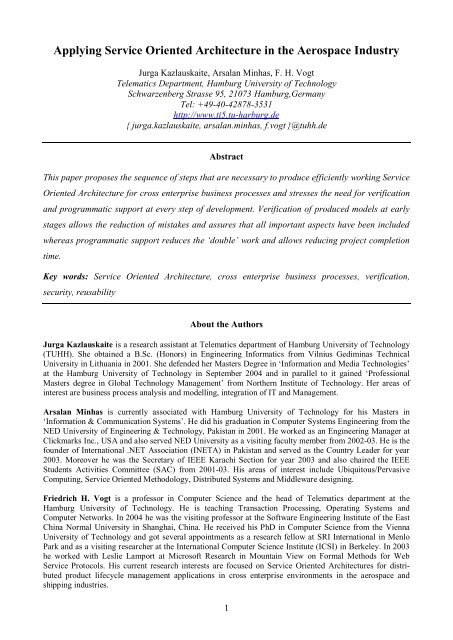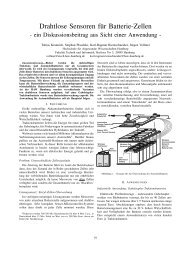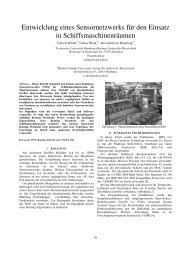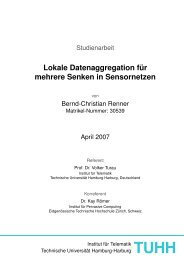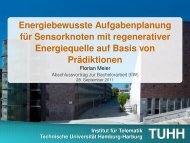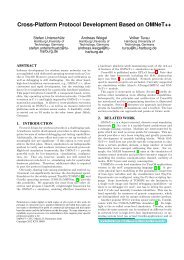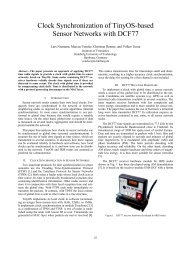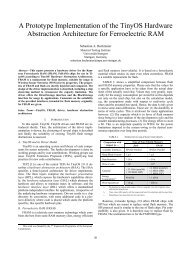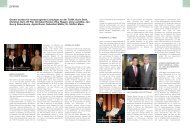Applying Service Oriented Architecture in the Aerospace Industry
Applying Service Oriented Architecture in the Aerospace Industry
Applying Service Oriented Architecture in the Aerospace Industry
You also want an ePaper? Increase the reach of your titles
YUMPU automatically turns print PDFs into web optimized ePapers that Google loves.
<strong>Apply<strong>in</strong>g</strong> <strong>Service</strong> <strong>Oriented</strong> <strong>Architecture</strong> <strong>in</strong> <strong>the</strong> <strong>Aerospace</strong> <strong>Industry</strong>Jurga Kazlauskaite, Arsalan M<strong>in</strong>has, F. H. VogtTelematics Department, Hamburg University of TechnologySchwarzenberg Strasse 95, 21073 Hamburg,GermanyTel: +49-40-42878-3531http://www.ti5.tu-harburg.de{ jurga.kazlauskaite, arsalan.m<strong>in</strong>has, f.vogt }@tuhh.deAbstractThis paper proposes <strong>the</strong> sequence of steps that are necessary to produce efficiently work<strong>in</strong>g <strong>Service</strong><strong>Oriented</strong> <strong>Architecture</strong> for cross enterprise bus<strong>in</strong>ess processes and stresses <strong>the</strong> need for verificationand programmatic support at every step of development. Verification of produced models at earlystages allows <strong>the</strong> reduction of mistakes and assures that all important aspects have been <strong>in</strong>cludedwhereas programmatic support reduces <strong>the</strong> ‘double’ work and allows reduc<strong>in</strong>g project completiontime.Key words: <strong>Service</strong> <strong>Oriented</strong> <strong>Architecture</strong>, cross enterprise bus<strong>in</strong>ess processes, verification,security, reusabilityAbout <strong>the</strong> AuthorsJurga Kazlauskaite is a research assistant at Telematics department of Hamburg University of Technology(TUHH). She obta<strong>in</strong>ed a B.Sc. (Honors) <strong>in</strong> Eng<strong>in</strong>eer<strong>in</strong>g Informatics from Vilnius Gedim<strong>in</strong>as TechnicalUniversity <strong>in</strong> Lithuania <strong>in</strong> 2001. She defended her Masters Degree <strong>in</strong> ‘Information and Media Technologies’at <strong>the</strong> Hamburg University of Technology <strong>in</strong> September 2004 and <strong>in</strong> parallel to it ga<strong>in</strong>ed ‘ProfessionalMasters degree <strong>in</strong> Global Technology Management’ from Nor<strong>the</strong>rn Institute of Technology. Her areas of<strong>in</strong>terest are bus<strong>in</strong>ess process analysis and modell<strong>in</strong>g, <strong>in</strong>tegration of IT and Management.Arsalan M<strong>in</strong>has is currently associated with Hamburg University of Technology for his Masters <strong>in</strong>‘Information & Communication Systems’. He did his graduation <strong>in</strong> Computer Systems Eng<strong>in</strong>eer<strong>in</strong>g from <strong>the</strong>NED University of Eng<strong>in</strong>eer<strong>in</strong>g & Technology, Pakistan <strong>in</strong> 2001. He worked as an Eng<strong>in</strong>eer<strong>in</strong>g Manager atClickmarks Inc., USA and also served NED University as a visit<strong>in</strong>g faculty member from 2002-03. He is <strong>the</strong>founder of International .NET Association (INETA) <strong>in</strong> Pakistan and served as <strong>the</strong> Country Leader for year2003. Moreover he was <strong>the</strong> Secretary of IEEE Karachi Section for year 2003 and also chaired <strong>the</strong> IEEEStudents Activities Committee (SAC) from 2001-03. His areas of <strong>in</strong>terest <strong>in</strong>clude Ubiquitous/PervasiveComput<strong>in</strong>g, <strong>Service</strong> <strong>Oriented</strong> Methodology, Distributed Systems and Middleware design<strong>in</strong>g.Friedrich H. Vogt is a professor <strong>in</strong> Computer Science and <strong>the</strong> head of Telematics department at <strong>the</strong>Hamburg University of Technology. He is teach<strong>in</strong>g Transaction Process<strong>in</strong>g, Operat<strong>in</strong>g Systems andComputer Networks. In 2004 he was <strong>the</strong> visit<strong>in</strong>g professor at <strong>the</strong> Software Eng<strong>in</strong>eer<strong>in</strong>g Institute of <strong>the</strong> EastCh<strong>in</strong>a Normal University <strong>in</strong> Shanghai, Ch<strong>in</strong>a. He received his PhD <strong>in</strong> Computer Science from <strong>the</strong> ViennaUniversity of Technology and got several appo<strong>in</strong>tments as a research fellow at SRI International <strong>in</strong> MenloPark and as a visit<strong>in</strong>g researcher at <strong>the</strong> International Computer Science Institute (ICSI) <strong>in</strong> Berkeley. In 2003he worked with Leslie Lamport at Microsoft Research <strong>in</strong> Mounta<strong>in</strong> View on Formal Methods for Web<strong>Service</strong> Protocols. His current research <strong>in</strong>terests are focused on <strong>Service</strong> <strong>Oriented</strong> <strong>Architecture</strong>s for distributedproduct lifecycle management applications <strong>in</strong> cross enterprise environments <strong>in</strong> <strong>the</strong> aerospace andshipp<strong>in</strong>g <strong>in</strong>dustries.1
(SMEs) <strong>in</strong>volved <strong>in</strong> <strong>the</strong> Aviation <strong>in</strong>dustry. The goal of <strong>the</strong> <strong>in</strong>itiative is to offer a solution that wouldprovide safe and correct collaboration base foster<strong>in</strong>g <strong>in</strong>novation process of Airbus and support<strong>in</strong>gcooperat<strong>in</strong>g parties <strong>in</strong> fulfill<strong>in</strong>g <strong>the</strong>ir contractual agreements.Collaboration among companies will be improved and <strong>the</strong> product time-to-market decreased due toautomation of certa<strong>in</strong> process parts, more efficient exception handl<strong>in</strong>g and more transparentcooperation process. Cost reduction will also result from reduction of <strong>the</strong> amount of paper produced<strong>in</strong> <strong>the</strong> <strong>in</strong>teraction between Orig<strong>in</strong>al Equipment Manufacturer (OEM) and SMEs, bettercommunication and ability to move at a fast pace from product design to production phase anddelivery.2. Specifics of Aviation <strong>Industry</strong>Airbus is one of <strong>the</strong> world’s two dom<strong>in</strong>ant civil aircraft producers with its more than 150 sitesthroughout <strong>the</strong> world and 16 development and manufactur<strong>in</strong>g units spread<strong>in</strong>g <strong>in</strong> France, Germany,Spa<strong>in</strong> and <strong>the</strong> United K<strong>in</strong>gdom. Its share of <strong>the</strong> market grew steadily <strong>in</strong> 1980s [11]. In 2003 for <strong>the</strong>first time it ga<strong>in</strong>ed <strong>the</strong> leaders position <strong>in</strong> <strong>the</strong> market. Today it is one of those <strong>in</strong>dustries where f<strong>in</strong>alproducts or services result from cooperation of a huge number of enterprises. The <strong>in</strong>dustry can becharacterised by very complex and long life-cycle products (up to thirty-forty years), tightcooperation among companies of vary<strong>in</strong>g sizes lead<strong>in</strong>g to dependencies of different levels, nonplanableR&D cooperations , chang<strong>in</strong>g consensus/conflict constellations [9, 10] and many iterationsof <strong>the</strong> design and development processes. OEMs like Airbus are dependent upon performance andabilities of <strong>the</strong>ir strategic suppliers. A number of different cooperation directions like verticalcooperation between OEM and SMEs and horizontal between suppliers are to be considered whilemak<strong>in</strong>g proposals for improvement of <strong>the</strong> current supplier network. All partnerships reflect thataeronautics is a dynamic global bus<strong>in</strong>ess <strong>in</strong> which <strong>the</strong> drive for competitive advantage seeks out <strong>the</strong>best possible synergies, wherever <strong>the</strong>y can be found. Collaboration is constra<strong>in</strong>ed bycompetitiveness ra<strong>the</strong>r than geography [11].Around 80% of <strong>the</strong> production and design of different parts of an aircraft is outsourced or executed<strong>in</strong> collaboration with o<strong>the</strong>r enterprises [4]. Therefore SMEs are important players <strong>in</strong> this <strong>in</strong>dustry.The complexity of <strong>the</strong> supplier networks underl<strong>in</strong>es <strong>the</strong> fact that only <strong>in</strong> <strong>the</strong> region of Hamburg<strong>the</strong>re are approximately 500 supplier companies work<strong>in</strong>g directly or <strong>in</strong>directly for Airbus [4]. Thegoal to stay competitive <strong>in</strong> <strong>the</strong> market pushes OEMs from aviation <strong>in</strong>dustry to redesign <strong>the</strong>irlogistics networks [5] and to <strong>in</strong>tegrate <strong>in</strong>formation systems from product eng<strong>in</strong>eer<strong>in</strong>g throughproduction to delivery. The <strong>in</strong>tegration of several <strong>in</strong>formation systems shall not only speed up <strong>the</strong>communication and cooperation process but also makes it transparent. Therefore <strong>the</strong> improvements<strong>in</strong> ‘document and data exchange’ sector would have a positive impact for <strong>the</strong> whole suppliernetwork.3
ForewordInternational students contribute enormously to <strong>the</strong> vitality of our universities and <strong>the</strong>irsurround<strong>in</strong>g communities. They enrich <strong>the</strong> teach<strong>in</strong>g environment, streng<strong>the</strong>n researchcapacity, are valued by employers, enhance <strong>the</strong> cultural diversity of our towns and cities,and contribute more than £10 billion a year to our economy. In 2014, <strong>the</strong> UK rema<strong>in</strong>ed <strong>the</strong>second most popular student dest<strong>in</strong>ation <strong>in</strong> <strong>the</strong> world, after <strong>the</strong> United States, but our marketshare is slipp<strong>in</strong>g.Around <strong>the</strong> world, <strong>in</strong>creas<strong>in</strong>g numbers of young people are travell<strong>in</strong>g abroad to study. TheDepartment of Bus<strong>in</strong>ess, Innovation, and Skills estimates that <strong>the</strong> market will have doubledbetween 2010 and 2025. However, five Parliamentary Select Committees have expressedconcern that <strong>the</strong> UK will miss <strong>the</strong> opportunity to benefit from this growth because of <strong>the</strong>impact of migration policies. Much of this debate has focused on <strong>the</strong> <strong>in</strong>clusion of students <strong>in</strong>net migration targets, but this report considers one specific aspect of policy – <strong>the</strong> changes topost-study work opportunities.In March 2011, <strong>the</strong> Home Secretary, Theresa May, said that “The UK has a worldwidereputation for provid<strong>in</strong>g quality education to overseas students, and Brita<strong>in</strong> is rightly <strong>the</strong>dest<strong>in</strong>ation of choice for many people wish<strong>in</strong>g to study abroad.” That reputation has madeUK education a major export. Our <strong>in</strong>quiry considered what impacts <strong>the</strong> closure of <strong>the</strong> Tier 1PSW route has had on <strong>the</strong> attractiveness of <strong>the</strong> UK as a dest<strong>in</strong>ation to study. We found that<strong>in</strong> <strong>the</strong> five years prior to <strong>the</strong> new rules tak<strong>in</strong>g effect <strong>in</strong> 2012, student numbers cont<strong>in</strong>ued togrow, but <strong>in</strong> <strong>the</strong> follow<strong>in</strong>g year we saw <strong>the</strong> first fall.In particular, important student markets to <strong>the</strong> UK such as India, Nigeria, Pakistan, andJapan have seen sharp decl<strong>in</strong>es. The overall impact has been offset by <strong>the</strong> cont<strong>in</strong>u<strong>in</strong>g boom<strong>in</strong> Ch<strong>in</strong>ese students enroll<strong>in</strong>g <strong>in</strong>to UK higher education, who now exceed any o<strong>the</strong>rnationality: 87,895 Ch<strong>in</strong>ese students enrolled <strong>in</strong> 2013 and Indian students were secondhighest at 19,750. But we heard concerns about <strong>the</strong> over-dependence on one country.We found that <strong>the</strong> Government’s own estimate that its policies would reduce those secur<strong>in</strong>gvisas by 49% significantly underestimated <strong>the</strong> impact – with <strong>the</strong> real reduction be<strong>in</strong>g closerto 88%. We heard evidence of students <strong>in</strong>stead apply<strong>in</strong>g to countries with a better post studywork offer. Countries such as Australia had enhanced <strong>the</strong>ir PSW offer after see<strong>in</strong>g <strong>the</strong>ir ownnumbers fall<strong>in</strong>g follow<strong>in</strong>g restrictions to <strong>the</strong>ir offer.Small bus<strong>in</strong>esses told us of <strong>the</strong> <strong>in</strong>creas<strong>in</strong>g difficulty <strong>in</strong> recruit<strong>in</strong>g from <strong>the</strong> pool of <strong>in</strong>ternationalstudents. These difficulties were <strong>in</strong> acquir<strong>in</strong>g a sponsor license, coupled with <strong>the</strong> basic salaryrequirement of £20,500, and that a number of SMEs ei<strong>the</strong>r lack <strong>the</strong> expertise of gett<strong>in</strong>g asponsor license or do not pay <strong>the</strong> basic ‘entrant’ salary required by <strong>the</strong> Home Office. Wealso found that <strong>the</strong> majority of sponsor licenses are <strong>in</strong> <strong>the</strong> South East of England, with o<strong>the</strong>rregions as well as Scotland, Nor<strong>the</strong>rn Ireland, and Wales be<strong>in</strong>g badly affected by a lack oftake-up from SMEs.Universities are also see<strong>in</strong>g sharp decl<strong>in</strong>es <strong>in</strong> students from key markets that contribute asignificant proportion of STEM enrolments. Some universities are threatened with clos<strong>in</strong>gdepartments and o<strong>the</strong>rs are beg<strong>in</strong>n<strong>in</strong>g to grapple with <strong>the</strong> lack of diversity on campuses.Some students told us that if <strong>the</strong>y had known <strong>the</strong> difficulties <strong>in</strong> f<strong>in</strong>d<strong>in</strong>g employment <strong>in</strong> <strong>the</strong> UKafter <strong>the</strong> completion of <strong>the</strong>ir studies, <strong>the</strong>y would have gone elsewhere. O<strong>the</strong>rs found it<strong>in</strong>creas<strong>in</strong>gly difficult to f<strong>in</strong>d employers will<strong>in</strong>g to take <strong>the</strong>m on at <strong>the</strong> basic entrant salaryrequirement <strong>in</strong> Tier 2.Our competitor countries offer far more generous post-study work opportunities than wecurrently do. The previous Tier 1 PSW route <strong>in</strong> <strong>the</strong> UK allowed students significant flexibilityAPPG on Migration - UK post study work opportunities for <strong>in</strong>ternational students 4
<strong>in</strong>formation about ma<strong>in</strong>tenance operations could help suppliers as well to plan more precisely whenand how many parts to produce for replacement.Ano<strong>the</strong>r important aspect is that time-frames for Airbus with<strong>in</strong> which <strong>the</strong>y promise to react to <strong>the</strong>requests received from <strong>the</strong>ir suppliers are not clearly def<strong>in</strong>ed or stated <strong>in</strong> any documentation whichmakes <strong>the</strong> overall process very unpredictable and error prone.We will see how our proposed solution based upon <strong>Service</strong> <strong>Oriented</strong> Methodology can assist <strong>in</strong>address<strong>in</strong>g all <strong>the</strong>se issues. It will not only solve <strong>the</strong> suppliers’ concerns related to GRESS but willalso make <strong>the</strong> vertical (between OEM and suppliers) and horizontal (among suppliers) workflowsmature and more discipl<strong>in</strong>ed. All <strong>the</strong> parties will be able to communicate effectively because oftransparent data and <strong>in</strong>formation exchange and will also be able to react faster to appear<strong>in</strong>gexceptions and chang<strong>in</strong>g deadl<strong>in</strong>es and priorities. This will result <strong>in</strong> overall reduction <strong>in</strong> productiontime and cost, speedy communication, enhanced co-operation and above all ‘documents and dataexchange’ <strong>in</strong> a standardized way as outl<strong>in</strong>ed by SOA. Enhanced collaboration would also speed up<strong>the</strong> preparation of Design Def<strong>in</strong>ition Dossiers, which is often done <strong>in</strong> conjunction with SMEs.3. How <strong>Service</strong> Orientation fits <strong>in</strong>?<strong>Service</strong> Orientation (SO) is NOT a technology or a product but a paradigm or an approach tobuild<strong>in</strong>g Systems us<strong>in</strong>g <strong>Service</strong>s which adhere to four tenets of <strong>Service</strong> Orientation:1. Boundaries are Explicit2. <strong>Service</strong>s are Autonomous3. <strong>Service</strong>s share Schema and Contract, not Class4. <strong>Service</strong> compatibility is determ<strong>in</strong>ed based on PolicyA System is a set of deployed <strong>Service</strong>s cooperat<strong>in</strong>g <strong>in</strong> a given task. System is built to change andadapt to new services after deployment. <strong>Service</strong> can be considered as an entity that is <strong>in</strong>teractedwith via message exchanges. Unlike Systems, <strong>the</strong>y are built to last and <strong>the</strong>ir availability andstability are of critical importance. <strong>Service</strong>s are fractals which means that a service can becomposed of sub-services; sub-services can be composed of fur<strong>the</strong>r sub-services and so on.Although <strong>the</strong>re are a number of parallels of SO with Object Orientation (OO) but <strong>the</strong>re are somedifferences as well. There is a trade-off between ease of programm<strong>in</strong>g and flexibility. <strong>Service</strong>s arema<strong>in</strong>ly about reduc<strong>in</strong>g shared assumptions, more flexible while Object Orientation is ma<strong>in</strong>ly aboutease of use, transparency, lots of assumptions and less flexible. In OO, complete fidelity with localcontract exists, boundaries are harder to isolate, types are shared and not schemas, objects aretightly coupled and offers platform-based compatibility. Unlike <strong>Service</strong>s reduce assumptions5
this objective <strong>the</strong> current <strong>in</strong>flexible applications should be <strong>in</strong>tegrated with <strong>the</strong> help of additionalservices to provide needed flexibility, transparency and scalability.Requirementscaptur<strong>in</strong>gGraphicalmodel<strong>in</strong>gRequirementsvalidationIdentificationof cooperationparametersSelection ofWS-ProtoclsWS-Protocolverification(TLA+/ TLC)ImplementationSystemvalidation/test<strong>in</strong>g(SXQT)Figure1: System development stepsTo enable <strong>the</strong> collaboration among various enterprise systems and with <strong>the</strong> goal to implement SOapproach, development starts with <strong>the</strong> analysis of exist<strong>in</strong>g data and <strong>in</strong>formation flows. Capturedrequirements and observed <strong>in</strong>teractions among different actors are depicted <strong>in</strong> a graphical view(figure 1, stage 1). For graphical representation we propose us<strong>in</strong>g actor perspective.Hav<strong>in</strong>g <strong>the</strong> diagram depict<strong>in</strong>g actor perspective is a relevant issue s<strong>in</strong>ce <strong>the</strong> second step of ourapproach is model validation. This can be done by demonstrat<strong>in</strong>g and discuss<strong>in</strong>g <strong>the</strong> producedmodels with <strong>the</strong> process owners. The perspective mentioned makes it easier for <strong>the</strong> owners ofdifferent process steps to identify <strong>the</strong>mselves with <strong>the</strong> <strong>in</strong>formation presented <strong>in</strong> <strong>the</strong> diagrams andallows gett<strong>in</strong>g more precise feedback on <strong>the</strong> miss<strong>in</strong>g aspects. The use of graphical cooperationmodels <strong>in</strong>clud<strong>in</strong>g <strong>the</strong> actor perspective also allows verify<strong>in</strong>g that all actual data and <strong>in</strong>formationflows are depicted.The third step after model<strong>in</strong>g and verification is to derive <strong>the</strong> cooperation specific parameters likesecurity, safety, messag<strong>in</strong>g from <strong>the</strong> diagrams and feedback of <strong>the</strong> process step owners. Later on,based on <strong>the</strong> derived parameters, selection of <strong>the</strong> available WS-Protocols, which satisfy <strong>the</strong>requirements, follows. A large number of protocols that use <strong>the</strong> SOAP [16] conventions formessage exchange are now under development [8].To make sure <strong>the</strong> chosen protocols will work as <strong>in</strong>tended, <strong>the</strong> verification of <strong>the</strong> successfulcoexistence of <strong>the</strong> selected protocols is advisable for determ<strong>in</strong><strong>in</strong>g errors at early stages. Check<strong>in</strong>gfor conformance at this stage is omitted by <strong>the</strong> <strong>in</strong>dustry today. Our model (figure 1, step 4) proposesvalidation us<strong>in</strong>g TLA+ - The Temporal logic of Action for concurrent reactive systems - a languagefor writ<strong>in</strong>g high-level specifications of concurrent systems [8]. Unlike most specification languages,it is based on ma<strong>the</strong>matics ra<strong>the</strong>r than programm<strong>in</strong>g-language constructs. Ma<strong>the</strong>matical modelshave to analyze <strong>the</strong> dependencies among different applications; for <strong>in</strong>stance guarantee<strong>in</strong>g correcttransaction rollback <strong>in</strong> case of a system crash. O<strong>the</strong>rwise it might lead to crucial mistakes <strong>in</strong>situations where actions taken by one application depend on data stored <strong>in</strong> o<strong>the</strong>r application.7
After successful verification process f<strong>in</strong>al development steps and implementation can follow (figure1, step 5).Normally newly implemented systems have to under go extensive test<strong>in</strong>g. Up to know test<strong>in</strong>g wasdone manually and a number of standard and exceptional situations had to be simulated aga<strong>in</strong>stwhich <strong>the</strong> application was tested later on. Simulation of test situations and test<strong>in</strong>g itself requiresadditional time and man power. In our case implemented protocols are exposed to permanentautomatic validation under real environment conditions with <strong>the</strong> help of Specifications us<strong>in</strong>gXQuery expressions on Traces (SXQT) [15]. SXQT specification technique allows detect<strong>in</strong>g nonconformances<strong>in</strong> <strong>the</strong> occurr<strong>in</strong>g message sequences, when compared aga<strong>in</strong>st protocol specification.The flow of real message exchange is used for <strong>the</strong> validation purposes to see whe<strong>the</strong>r <strong>the</strong> protocolswork <strong>the</strong> way that was <strong>in</strong>tended. The permanent validation is not limited to a number of simulatedsituations, <strong>the</strong> system is validated with each exception appear<strong>in</strong>g, it does not require <strong>in</strong>volvement ofdevelopers, excludes mistakes related to <strong>the</strong> human factor, <strong>in</strong>forms developers whenever somedeviations appear and <strong>in</strong> such a way supports developers <strong>in</strong> creation of conform<strong>in</strong>gimplementations. Validation us<strong>in</strong>g SXQT can be implemented for early prototypes, for f<strong>in</strong>alimplementations or <strong>in</strong> real world work<strong>in</strong>g environments.The proposed model with <strong>the</strong> verification follow<strong>in</strong>g every stage contributes to creation of properlywork<strong>in</strong>g flexible and extensible systems, while reus<strong>in</strong>g current implementations. This approachenables exclusion of systems errors at <strong>the</strong> earliest stages possible and allows sav<strong>in</strong>g time and costsdue to reduced number of man hours required for test situation simulation and ma<strong>in</strong>tenance of <strong>the</strong>system.5. Case StudyFor <strong>the</strong> purpose of <strong>in</strong>ternal and cross enterprise process analysis and to depict <strong>the</strong> <strong>in</strong>teractionbetween an OEM and SMEs, <strong>the</strong> bus<strong>in</strong>ess processes between Airbus (OEM) and Innov<strong>in</strong>t AircraftInterior GmbH (SME) have been analyzed.The data was collected by one of <strong>the</strong> authors that stayed at Innov<strong>in</strong>t AG for one month on full timebasis. The <strong>in</strong>formation concern<strong>in</strong>g eng<strong>in</strong>eer<strong>in</strong>g bus<strong>in</strong>ess process (milestones, development process,Airbus requirements for equipment and system suppliers, product structure) was obta<strong>in</strong>ed, <strong>the</strong> studyof exist<strong>in</strong>g documents related to various orders was made and employees <strong>in</strong>volved <strong>in</strong> execution ofdifferent process steps were <strong>in</strong>terviewed.It was discovered that companies need to comply with certa<strong>in</strong> steps and time spans for variousmilestones while design<strong>in</strong>g and develop<strong>in</strong>g products for Airbus. They are precisely described <strong>in</strong>GRESS provided by <strong>the</strong> OEM. Telephones and faxes are still used very extensively for exchang<strong>in</strong>g8
data and <strong>in</strong>formation <strong>in</strong> aerospace <strong>in</strong>dustry. EDI will be required for cooperation with OEM <strong>in</strong> <strong>the</strong>near future. On <strong>the</strong> o<strong>the</strong>r end, Innov<strong>in</strong>t is us<strong>in</strong>g Harmony system [17] for Customer RelationshipManagement (CRM).Complex <strong>in</strong>teraction processes for different products were modelled after <strong>the</strong> requirementscaptur<strong>in</strong>g phase. Production of <strong>the</strong> Innov<strong>in</strong>t can be divided <strong>in</strong>to two big groups: standard productsand project products. The project products are s<strong>in</strong>gle units developed and produced on specialrequest. The workflow of <strong>the</strong> project products extends <strong>the</strong> standard product order<strong>in</strong>g process. Latervalidation of <strong>the</strong> developed models followed. The graphical bus<strong>in</strong>ess process representations werepresented to and discussed with <strong>the</strong> owners of different process steps. After several revisions andmodel improvement cycles graphical representations were approved by <strong>the</strong> employees of <strong>the</strong>company.Fur<strong>the</strong>r on <strong>the</strong> approved diagrams were used to derive <strong>the</strong> relevant parameters of communication,data and <strong>in</strong>formation flows <strong>in</strong> a distributed bus<strong>in</strong>ess environment, as well as to identify <strong>the</strong>bottlenecks and get early alerts for application specific exception handl<strong>in</strong>g [8]. The outcomes of <strong>the</strong>research were documented <strong>in</strong> a form of Software Requirements Specification (SRS). SRS alsodescribes requirements for <strong>the</strong> <strong>in</strong>tegration of <strong>the</strong> CRM software <strong>in</strong>stalled <strong>in</strong> <strong>the</strong> company with <strong>the</strong>state-of-<strong>the</strong>-art collaboration platform e.g. [12-14]. This solution will provide an <strong>in</strong>sight to <strong>the</strong>project status at <strong>the</strong> Innov<strong>in</strong>t for <strong>the</strong>ir customers and suppliers and will be used for record<strong>in</strong>g ofwork<strong>in</strong>g patterns. The customers will be able to check <strong>the</strong>ir order status, see whe<strong>the</strong>r <strong>the</strong>re are anydelays and prove <strong>the</strong> availability of standard products of <strong>the</strong>ir <strong>in</strong>terest. An <strong>in</strong>sight to <strong>the</strong> projectorderstatus will allow to better plan and coord<strong>in</strong>ate cooperative design and development projectsamong <strong>the</strong> companies <strong>in</strong>volved.Prototyp<strong>in</strong>g implement<strong>in</strong>g all identified distributed functions us<strong>in</strong>g <strong>the</strong> standard and proven WSprotocolshas been chosen to avoid leav<strong>in</strong>g out any significant <strong>in</strong>formation that was not wellcommunicated <strong>in</strong> <strong>the</strong> requirements captur<strong>in</strong>g phase. It will also help <strong>the</strong> users and designers of <strong>the</strong>future system to better understand and comment on <strong>the</strong> features and will allow us f<strong>in</strong>aliz<strong>in</strong>gcooperation parameters. “Prevention of defects beg<strong>in</strong>s with better ways to capture, represent, andvalidate <strong>the</strong> objectives and requirements of systems we are try<strong>in</strong>g to build...”[2]Up to now <strong>the</strong> project members had to face <strong>the</strong> problem of mak<strong>in</strong>g implicit knowledge of processowners explicit by depict<strong>in</strong>g it <strong>in</strong> a graphical form. This moment is critical, s<strong>in</strong>ce it allows later onmore efficient <strong>in</strong>tegration of <strong>the</strong> relevant knowledge <strong>in</strong>to <strong>the</strong> system developed. The difficultiesarose because people <strong>in</strong> <strong>the</strong> company did not th<strong>in</strong>k about <strong>the</strong>ir work <strong>in</strong> terms of process and dataflows and <strong>the</strong> eng<strong>in</strong>eer<strong>in</strong>g sub processes vary significantly depend<strong>in</strong>g on <strong>the</strong> type of <strong>the</strong> product.9
With this project we try to <strong>in</strong>troduce more transparency <strong>in</strong> cross enterprise bus<strong>in</strong>ess process, byreduc<strong>in</strong>g <strong>the</strong> number of media cuts and provid<strong>in</strong>g <strong>in</strong>sight <strong>in</strong>to Innov<strong>in</strong>t order statuses for <strong>the</strong>ircustomers and suppliers. We believe that our solution fulfils <strong>the</strong> need for future bus<strong>in</strong>ess benefits byhelp<strong>in</strong>g employees and decision makers to be more productive, while allow<strong>in</strong>g organizations to takeadvantage of <strong>the</strong>ir <strong>in</strong>vestment <strong>in</strong> exist<strong>in</strong>g systems. It will add value to <strong>the</strong> bus<strong>in</strong>ess by:1. Network<strong>in</strong>g disconnected islands of data. Many enterprises store <strong>in</strong>formation <strong>in</strong> multiplelocations like file shares, <strong>in</strong>dividual users' hard drives, <strong>in</strong> multiple bus<strong>in</strong>ess applications andformats, or locked away <strong>in</strong> databases. Lack of structured content repository and no common<strong>in</strong>frastructure for distribution of <strong>the</strong> <strong>in</strong>formation are real bottlenecks for enterprises.Frequently, users must search multiple locations to f<strong>in</strong>d <strong>the</strong> right piece of <strong>in</strong>formation. Thiscan be time-consum<strong>in</strong>g and difficult, and sometimes users abandon <strong>the</strong> search before <strong>the</strong>yf<strong>in</strong>d useful <strong>in</strong>formation.To understand <strong>the</strong>ir bus<strong>in</strong>ess and carry it out effectively, organizations must unify this<strong>in</strong>formation with a s<strong>in</strong>gle po<strong>in</strong>t of access. We hope that our solution will ensure an easydistribution of <strong>in</strong>formation amongst customers, suppliers and partners hav<strong>in</strong>g no common<strong>in</strong>frastructure among <strong>the</strong>m. By ty<strong>in</strong>g toge<strong>the</strong>r disconnected islands of data, organizations cancapture and ma<strong>in</strong>ta<strong>in</strong> <strong>the</strong> competitive advantage. The result is a more effective organizationthat can identify trends and react to <strong>the</strong>m quickly.2. Integrat<strong>in</strong>g disparate bus<strong>in</strong>ess processes. No portion of an organization's bus<strong>in</strong>ess is carriedout <strong>in</strong> isolation. However, many bus<strong>in</strong>ess applications use proprietary protocols, do not<strong>in</strong>tegrate with o<strong>the</strong>r applications, and require <strong>the</strong>ir own user credentials to sign <strong>in</strong>. More andmore organizations are look<strong>in</strong>g for ways to <strong>in</strong>tegrate <strong>the</strong>ir bus<strong>in</strong>ess processes so <strong>the</strong>y canstreaml<strong>in</strong>e operations and share <strong>in</strong>formation more effectively.By provid<strong>in</strong>g Web <strong>Service</strong>s <strong>in</strong>terfaces, our solution is open for additional functionality andfor <strong>in</strong>tegration <strong>in</strong>to exist<strong>in</strong>g systems and processes. Us<strong>in</strong>g <strong>the</strong> standard Web <strong>Service</strong>sprotocols and adher<strong>in</strong>g to <strong>the</strong> SO methodology provide an <strong>in</strong>tegrated environment for newand exist<strong>in</strong>g applications. The <strong>in</strong>tegration of Harmony CRM system <strong>in</strong> our case study provesthat exist<strong>in</strong>g bus<strong>in</strong>ess processes can be <strong>in</strong>tegrated without abandon<strong>in</strong>g <strong>in</strong>vestments <strong>in</strong>exist<strong>in</strong>g systems.3. Help<strong>in</strong>g suppliers, customers, partners to collaborate effectively. Teams need tocommunicate, share tasks, and work toge<strong>the</strong>r <strong>in</strong> order to get <strong>the</strong>ir work done. Additionally,team members often need to work with people from o<strong>the</strong>r teams and divisions to completetasks. This is even more difficult when people are located <strong>in</strong> different locations.10
We believe that our proposed solution can help f<strong>in</strong>d, communicate, and collaborate withpeople no matter where <strong>the</strong>y are located. It will allow users to receive notices and alertsabout <strong>the</strong> changes made to <strong>the</strong> documents and <strong>the</strong> milestone plans, as well as about <strong>the</strong>deadl<strong>in</strong>es of <strong>the</strong> tasks to be executed. For customers it will provide an access to documents,data, <strong>in</strong>formation, and applications. This can help organization to take advantage of manybus<strong>in</strong>ess-to-bus<strong>in</strong>ess opportunities. For example, customers can view <strong>the</strong> status of <strong>the</strong>irorders; check <strong>the</strong> availability of a specific item, or possible delays. The implementation willalso help to record <strong>the</strong> users work<strong>in</strong>g habits on which future improvements will be based.The goal of this system is to enable users to faster react to appear<strong>in</strong>g exceptions because ofan automated notification process and <strong>in</strong>troduce more transparency to <strong>the</strong> data and<strong>in</strong>formation exchange process. The end result is an organization that is more efficient andeffective <strong>in</strong> its work, which translates <strong>in</strong>to better productivity and higher employeesatisfaction.6. ConclusionsThe present paper describes <strong>the</strong> six steps approach for successful <strong>Service</strong> <strong>Oriented</strong> <strong>Architecture</strong> thatconcentrates on <strong>in</strong>tegration of currently runn<strong>in</strong>g and future applications by provid<strong>in</strong>g Web <strong>Service</strong>s<strong>in</strong>terfaces. The <strong>in</strong>vestigations are be<strong>in</strong>g fur<strong>the</strong>r backed up by <strong>the</strong> development of solution forInnov<strong>in</strong>ts’ cooperation with its customers and suppliers, especially concentrat<strong>in</strong>g on <strong>the</strong> observed<strong>in</strong>teraction with Airbus. Till this moment <strong>the</strong> first four steps: bus<strong>in</strong>ess process modell<strong>in</strong>g, validationof requirements, selection of WS-Protocol and its verification/model check<strong>in</strong>g have beencompleted. Prototype implementation is <strong>in</strong> progress which will be followed by <strong>the</strong> systemvalidation. It is hoped that this work will demonstrate how companies affected by <strong>the</strong> tendency ofmass customisation can still make best use of <strong>the</strong>ir IT technology <strong>in</strong>vestments by provid<strong>in</strong>g<strong>in</strong>terfaces to <strong>the</strong>ir systems and implement<strong>in</strong>g <strong>Service</strong> <strong>Oriented</strong> <strong>Architecture</strong>. If successful over arange of systems, <strong>the</strong> <strong>in</strong>vestigation will provide a base for a plausible <strong>the</strong>ory of and efficient andeffective SOA development.Apart from any <strong>the</strong>oretical advance that this study will provide, it should, if successful, lead to <strong>the</strong>development of methods and tools for SOA creation. The study aims at contribut<strong>in</strong>g to creation ofmore advanced applications that greatly improve cross enterprise bus<strong>in</strong>ess process efficiency,transparency and flexibility by <strong>in</strong>tegrat<strong>in</strong>g a number of enterprise applications, unify<strong>in</strong>g data and<strong>in</strong>formation stored and provid<strong>in</strong>g a s<strong>in</strong>gle po<strong>in</strong>t of access for employees, customers and suppliers.References:[1] – Norman, R. and Forte, G., International Workshop on Computer-Aided Software Eng<strong>in</strong>eer<strong>in</strong>g[2] – Baetjer, H. Jr. (1998). Software as capital. An Economic Perspective on Software Eng<strong>in</strong>eer<strong>in</strong>g.11
[3] – Newcomer, E., Lomow, G. (2005). Understand<strong>in</strong>g SOA with Web <strong>Service</strong>s.[4] – Vogt, F.H. (2005) Erhöhung der Sicherheit und Flexibilität verteilter Kooperation durch dieE<strong>in</strong>führung serviceorientierter Konzepte <strong>in</strong> verteilten Unternehmen, will appear <strong>in</strong> a special issue ofTUHH Spektrum.[5] – Von He<strong>in</strong>er, S. (2004, August 23). Airbus will Zulieferfirmen aussortieren. Die Welt.[6] – Theis, C. (1997). Qualitätsmanagement zwischenbetrieblicher Kooperationen. Berichte ausder Produktionstechnik Vol. 12/97, Ph.D <strong>the</strong>sis, RWTH Aachen, Germany.[7] - Welsh, J.A., White, J.F. (1981). A small bus<strong>in</strong>ess is not a little big bus<strong>in</strong>ess. Harvard Bus<strong>in</strong>essReview, 59:18-32.[8] – Johnson, J.E., Langworthy, D.E., Lamport, L., & Vogt, F.H. (2005). Formal Specification of aWeb <strong>Service</strong>s Protocol. Submitted for a special issue of Journal of Logic and AlgebraicProgramm<strong>in</strong>g[9] – Ke<strong>the</strong>rs, S. (2000). Multiperspective Modell<strong>in</strong>g and Analysis of Cooperation Processes. PhD<strong>the</strong>sis University of Aachen.[10]– Specht, G., Beckmann, C. (1996). F&E-Management. Schäffer-Poeschel Verlag, Stuttgart.[11] - Busqu<strong>in</strong>, P. and o<strong>the</strong>rs. (2001). Meet<strong>in</strong>g society’s needs and w<strong>in</strong>n<strong>in</strong>g global leadership.European Aeronautics: A Vision for 2020.[12] – Bra<strong>in</strong>loop Secure Dataroom description, Retrieved January 21, 2005 fromhttp://www.bra<strong>in</strong>loop.com/de/produkte/<strong>in</strong>dex.htm[13] – Documentum, Retrieved February 3, 2005, from www.documentum.com[14] – Microsoft SharePo<strong>in</strong>t Portal Server description of product, Retrieved January 25, 2005 fromhttp://www.microsoft.com/sharepo<strong>in</strong>t/[15] – Venzke, M. (2004). Specifications us<strong>in</strong>g XQuery Expressions on Traces. Retrieved March 1,2005, from Hamburg University of Technology, Telematik department Web site:http://www.ti5.tu-harburg.de/publication/2004/Paper/Venzke04a/Venzke_SXQT04.pdf[16] – Mitra, N. (2003, June 24). Soap version 1.2. part0: Primer, technical report, World WideWeb Consortium (W3C). Retrieved January 20, 2005 from http://www.w3.org/TR/2003/RECsoap12-part0-20030624/[17] – Harmony CRM system description. Retrieved February 4, 2005 from www.harmony.de12


